From Charlottesville to Kingsport to the world’s oceans, we look at what’s working — and not working — in our recycling system
Contributing Writers | February 13, 2023 | 2 Comments
By Matt Dhillon
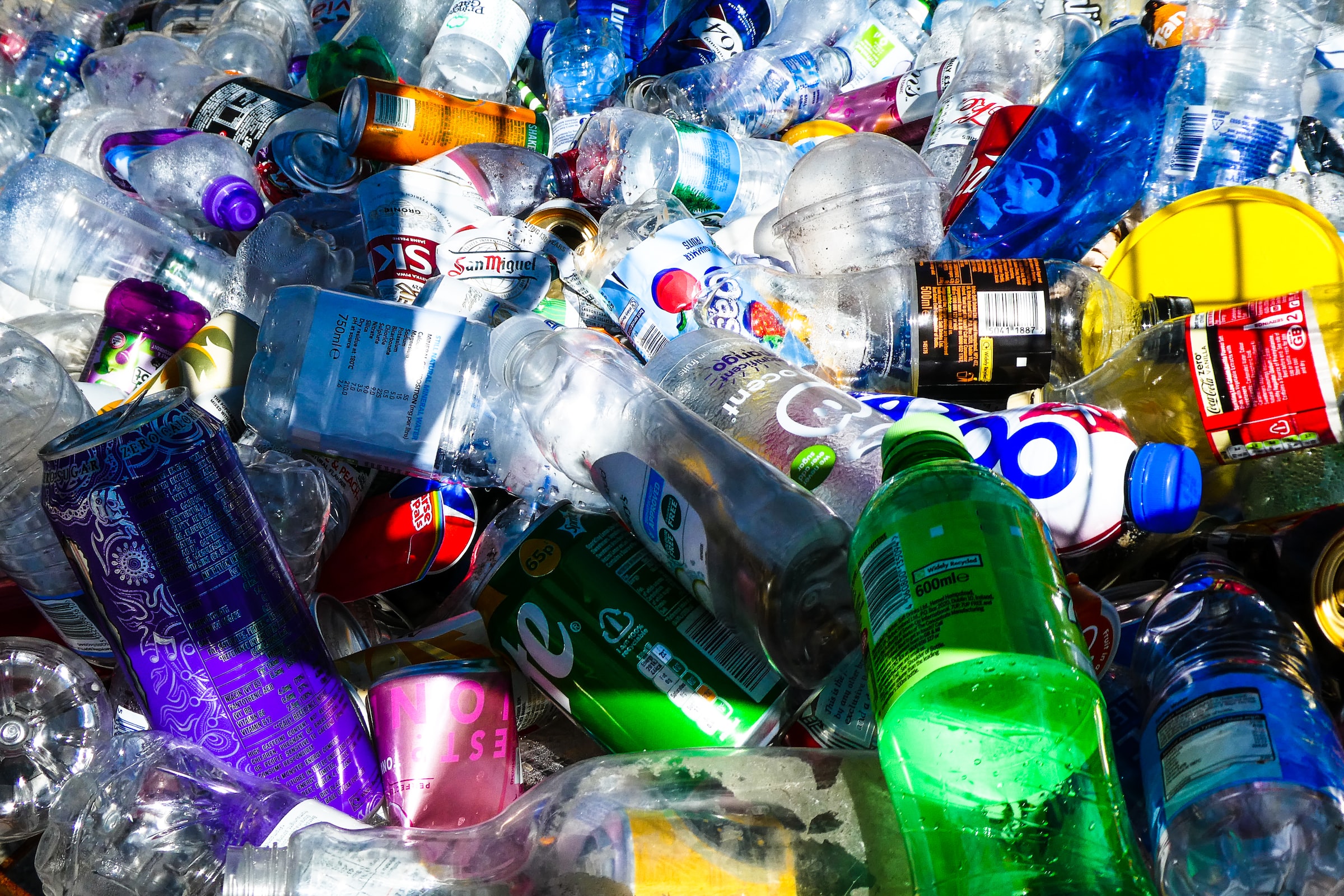
Only about 5% of plastic in the United States is ultimately recycled. Photo by Nick Fewings on Unsplash
Imagine an ordinary kitchen. It’s long, rectangular and in the corner are two cans, one black and one blue, the latter stamped with the distinctive triangle made of three folded arrows. You enter the kitchen with a plastic bottle, also ordinary, the contents of which you finish and casually take over to the trash. You almost toss it in the black bin but stop. Isn’t recycling the responsible thing to do?
But where does our recycling actually go? A lot less ends up getting recycled than you might think. A 2017 study of plastic production from the University of Georgia estimated that of the 6.3 billion metric tons of that plastic has been disposed of globally, 9% was recycled, 12% incinerated and 79% left in landfills or in the environment. Even local recycling programs have trouble finding places to take the material they collect.
As you pause, bottle in hand, you may reflect on images of trash resurfacing — sea turtles trapped in plastic rings, litter on the slopes of Mt. Everest, microplastics in the ice of Antarctica, garbage patches floating in the ocean.
So, you may wonder, addressing your bottle, how can I keep you from ending up in unsavory places like that?
According to Virginia’s Department of Environmental Quality, about half of the solid waste stream in Virginia is municipal waste. What we throw away has an impact — an 11,044,256-ton impact in Virginia alone, the agency’s 2020 recycling rate report shows.
Of that total, 5,307,568 tons (about 45%) was put in recycling by the end user, the report states. In that roughly 5 million tons floats your plastic bottle. Let’s take a closer look at that part of the stream.
In Charlottesville, Virginia, the Rivanna Solid Waste Authority operates two drop-off locations where people can take their recycling — the McIntire Recycling Center and the Ivy Material Utilization Center. Their website lists everything that residents can take there.
Philip McKalips, director of solid waste for the Rivanna Solid Waste Authority, says he hopes that a new recycling center will be opening soon to serve rural areas south of the city.
The McIntire Recycling Center has a lot to offer for people who bring their recycling directly to the center. There’s a compactor for cardboard and a collection area for mixed paper.
“Right now, these are both going to the same paper mill south of Richmond,” McKalips says.
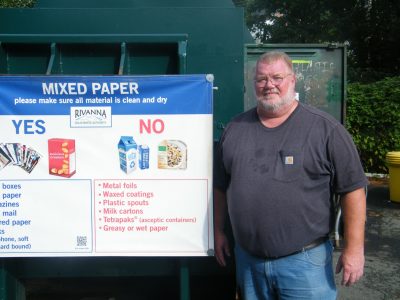
Charlottesville’s municipal recycling centers offer ways to recycle a wide range of goods. Photo by Matt Dhillon
Residents can bring their food waste and used cooking oil. That is part of an effort to keep people from putting grease down their drains.
“We take it to Panorama Farms where they compost it,” McKalips says. “The value of composting is incredible. Keeping all those organics out of landfills has a huge climate change impact.”
The location also collects spent oyster shells. The larvae latch on to the shells which are released into the Piankatank River. Oyster beds filter water and an adult oyster cleans more than 50 gallons of water a day.
“The first year we figured that we were going to be treating about 31 billion gallons of Chesapeake Bay water a year with just the oysters that we did,” McKalips says.
There’s even a can to collect plastic film of number 2 and number 4 type plastic, which includes shopping bags and most kinds of wrappers.
“There’s only one place this can go and that’s Trex up in Winchester,” McKalips says. “They make that synthetic wooden decking, the really nice stuff that never gets splinters.”
Then there’s more of the usual suspects, like glass.
“When the pile’s big enough, a company called Strategic Materials will come and pick it up,” McKalips says. The company has their own facility to sort and break the glass to make it ready to process back into bottles or fiberglass.
There are two large, green containers in the back of the lot. One is for scrap metal, which goes to a company called Gerdau in Roanoke, Virginia. The company will process and resell the scrap as raw material. The other container is for aluminum cans, which may be the most valuable material to recycle.
“Aluminum should never be just thrown out,” McKalips says. “It should always get recycled because it’s so recyclable, and it’s so valuable to recycle.”
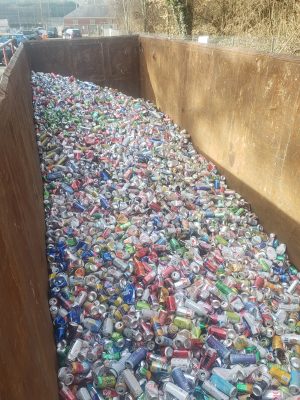
Empty aluminum cans are collected at McIntire Recycling Center in Charlottesville, Va. Aluminum is one of the world’s most recyclable materials. Photo by Matt Dhillon
But your bottle would go into the container for number 1 and 2 plastics. Plastic is a more complicated material to recycle. It comes in so many forms and composites that even pre-sorted plastic has to be sent to a material recovery facility where it is further sorted, baled into colorful blocks, and sold.
Most recycling does go through a material recovery facility for sorting before it can be reused, particularly single-stream recycling, in which all recyclable materials are combined. The city of Charlottesville contracts with GFL Environmental, Inc., a company based in Canada, to haul curbside recycling to GFL’sr private material recovery facility in Chesterfield, Virginia.
Every such facility, no matter what kinds of material they take in, is only able to recover a percentage of the waste and has a remainder that can’t be reused, which is called the residual stream.
Private recyclers are not required to report their data to regulatory agencies and usually don’t. GFL refused multiple requests for comment on this story, so it’s unclear what and how much is recovered in their material recovery facility. However, there are some broader indicators of where our waste is going.
Not everything we put into recycling bins ends up getting recycled (sorry, bottle). There are many dams and bottlenecks on the recycling stream that can impede your recyclable item on its journey.
One of the major factors in an item’s recyclability is the market — whether anyone wants to buy it. That is a reality that put a stop to the recycling program Kingsport, Tennessee, in 2020.
On the city of Kingsport’s website, an alert reads, “Due to a degraded market, Kingsport put its recycling program on pause. In the meantime, residents should continue to put out their recycling cans as normal.” Sullivan County still operates six recycling drop-off locations that accept a limited scope of recyclables, but single stream, curbside recycling is frozen. Residents still put out their recycling bins, but the trucks picking them up all go to the landfill.
In the past, Kingsport has had an exceptionally high recycling rate.
“Before the market came down in recycling, we were at about a 7% residual,” says Rodney Deel, sanitation manager for the city. Residuals are what’s in the stream that can’t be recycled. “Fifteen percent is an acceptable amount and we were half of that. Our recycling stream was clean.”
But then, in January 2018, the market for recyclables crashed when China stopped buying mixed waste that other countries couldn’t or didn’t want to recycle. Prior to that, China was the world’s largest importer of recyclables, particularly for hard-to-recycle plastics.
The move jammed the recycling stream globally. Domestic recyclers had more than they could handle. Material backed up in warehouses and the value of recyclables dropped as no buyers could be found.
“So, basically the cost of processing a shipment, it got to be way higher and I’m talking a lot more money than just putting it in the landfill,” Deel says.
Things got worse in 2020, the year that Covid uprooted the economy. Eventually the system caved when Kingsport’s processor asked for twice what Kingsport had paid them to take the last shipment. Meanwhile, there was no guarantee that the material shipped would be reused.
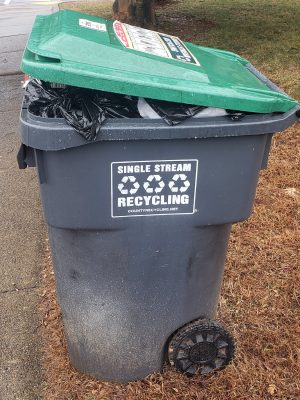
A curbside recycling bin awaits pickup in Charlottesville, Va. The town website states that recyclables should not be bagged, but this resident placed theirs in bags anyway. Photo by Matt Dhillon.
“Well, WestRock made $85 a ton and they’d pull off the cleanest stuff that they could sell for the market,” Deel says. “If plastic was up in the market and they could pull it off clean, then they would sell the plastic, and if paper was rock bottom or cardboard, they couldn’t make any money off of it, then the shipping cost would be more than to send it to the landfill.”
When Kingsport canceled their program, the city would have had to pay $625,000 that year to run it, with the majority of material getting landfilled anyway.
“The least expensive place for [WestRock] to take it would have been to the landfill,” Deel says. “They were upfront about that and that’s the reason why we said we didn’t want to collect something from people for it to just be taken to the landfill in a different place.”
Prior to 2018, your bottle had a good chance of going to China, Malaysia, Thailand or Indonesia. An investigation by the Guardian found that over half of plastic recycling from the US went to China or Hong Kong in 2015. There, it could pile up in villages and surround entire towns where a plastic-harvesting industry took hold. Villagers would have sorted out your bottle with anything else that could be salvaged and melted it into pellets. But well over half of the material would be dumped, landfilled or incinerated, the Guardian found.
“And we counted what we sent over to China as being recycled,” says Lisa Ramsden, senior oceans campaigner at Greenpeace. “So that’s probably why our recycling rates have dropped so dramatically over the past few years, because we’re no longer shipping our waste to China.”
According to the U.S. Environmental Protection Agency, the amount of plastic actually being recycled peaked in the U.S. in 2014 at 9.5% of the amount produced. After China changed its policy, estimates dropped to around 5%.
So does that mean that your bottle only has a 5% chance of being recycled?
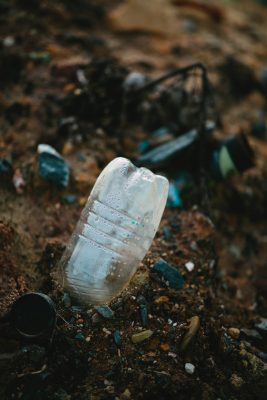
Even though clear, #1 plastic is the most recyclable form of plastic, most of it is not ultimately recycled. Photo by Markus Spiske on Unsplash
Five percent is low. In a plastic water bottle, 5% is less than the amount of plastic in the bottle cap. Consider that US households generated an estimated 51 million tons of plastic in 2021, according to Greenpeace.
Plastic is a large current in the solid waste stream. According to the EPA, plastic made up about 8.2% of municipal solid waste in 2018, but experts would estimate that number to be much higher.
Despite being the focus of most recycling campaigns, plastic has the lowest recycling rate of any material on EPA’s list. A report published by the environmental organization Greenpeace in October argues that the low numbers are because plastic is not in fact a recyclable material.
“So many cities want to greenwash it,” says Jan Dell, author of the report. “Then the plastics industry went around and tried to pretend it’s all recyclable because you’d put it in your bin and then it would get shipped off to China.”
But only a small portion of plastic is actually getting recycled, according to the Greenpeace analysis: about 20% of #1, about 10% of #2, with the other five categories scoring under 5% each.
“Actually, it’s only 1s and 2s, bottles and jugs,” Dell says. “So your clamshell, your cup, the packaging that comes on a thing of pencils at Walmart, none of that’s recyclable. It’s only bottles and jugs.”
The report collected data on which plastics material recovery facilities will accept and which plastics factories are capable of processing. Many single stream and curbside programs will take plastics numbered 1-7, but most of that comes out in residuals, meaning it’s what is left behind after sorting. In fact, collecting and claiming to recycle all of those plastics only increases contamination and drives sorting and contamination costs up.
“I don’t know a single factory in America that recycles most of those plastics, 3s, 4s, 6s,” Dell says. “There’s only one factory that does 5s. They’ll say they take 3-7s or they say they take #1 clamshells. There’s not a factory in America that recycles clamshells.”
Already, the journey down the recycling stream is a perilous one. More materials are lost at each step of the way. The first is collecting it.
In her report, Dell describes single use plastic as “trillions of pieces of plastic confetti spewed from retail and fast food stores to over 330 million U.S. residents across more than 3 million square miles (not counting Alaska and Hawaii) each year.” Since so much plastic — about 50% according to Dell — is single-use packaging, it’s practically impossible to get it all to a recycling facility. Much of it ends up in roadways, waterways or landfills.
The fraction that does make it to a recycling facility has to be extensively sorted. There are the seven different types of plastic categorized by their chemistry, but functionally there are thousands of different kinds of plastic with particular compositions, rigidity, and melting points that need to be processed differently. Some types of plastic leak toxins that can contaminate others.
Cost-benefit weighs heavily at this step. The more processing a particular quality of plastic involves and the harder it is to collect, the more it costs to recycle. If the value of the material is low, such as #4 and #5 plastic film or #6 Styrofoam, processing it probably won’t be economical and it has little chance of being recycled.
Even in facilities that focus on specific plastics, some material is lost. Dell estimates that in a facility that only accepts bottles and jugs, about 75% of the material would be recycled, and her report cites that a facility in Mexico for recycling #1 bottles predicts that 30% of the material will be lost in processing.
Finally, the market determines how much of that material will actually get used. Recycling plastic is only effective if it reduces the amount of virgin plastic produced. But plastic production continues to trend upward with 407 million metric tons produced globally in 2015, up from 274 million metric tons in 2010, according to researchers at the University of Georgia.
New plastic is cheaper to produce than recycled plastic, which means there’s not much incentive for companies to use recycled plastic. As the market demonstrated in 2018 after China changed its plastic policy, a load of recycling with no buyer will end up in a landfill.
Since your bottle is #1 — clear, uncontaminated, and the most desirable type of plastic — it has a pretty good chance of being recycled. It could become another bottle or be turned into polyester fibers for a variety of different clothing.
Almost half of plastic production continues to be single-use, disposable packaging, designed to be thrown away, according to Dell. Since there is no reliable way to recycle it or even collect it, much of that material is destined to become pollution from the moment it’s manufactured.
Consumers can’t decide to stop the production of harmful waste, but if they want to make an impact they can work to phase it out of their routine. Plastic waste seems ubiquitous now, but that ordinary cup or bottle only seems ordinary crumpled up in a trash can. Reimagine that plastic cup rolled up in the roots of a sycamore tree, piled in a Malaysian village, or floating on the open ocean, and suddenly it’s not ordinary, it’s bizarre.
Like this content? Subscribe to The Voice email digests
Thank you Matt for this insightful report! I was just discussing the plight of our unused waste on the planet- both physical and digital waste- and found your article very timely. The problem seems so insurmountable, but we have to believe a better future is possible. I will at least start bringing more recylables to McIntyre in person. Please publish more articles like these with updated statistics! Thank you, Ashlynn, Kevin, and Baby Dylan
Great article. Have often thought that single-stream was at least part of the problem. The requirement to sort everything (including things accidentally thrown in, like chewing gum) downstream, makes it such a painful and expensive thing to do. What if we just recycle aluminum and have bins just for aluminum cans with a way to check to make sure your product is aluminum and not another kind of metal? Then we have a profitable way of recycling. Once people get in the habit, we can phase in a receptacle for #1 plastic, another for glass, another for paper etc.